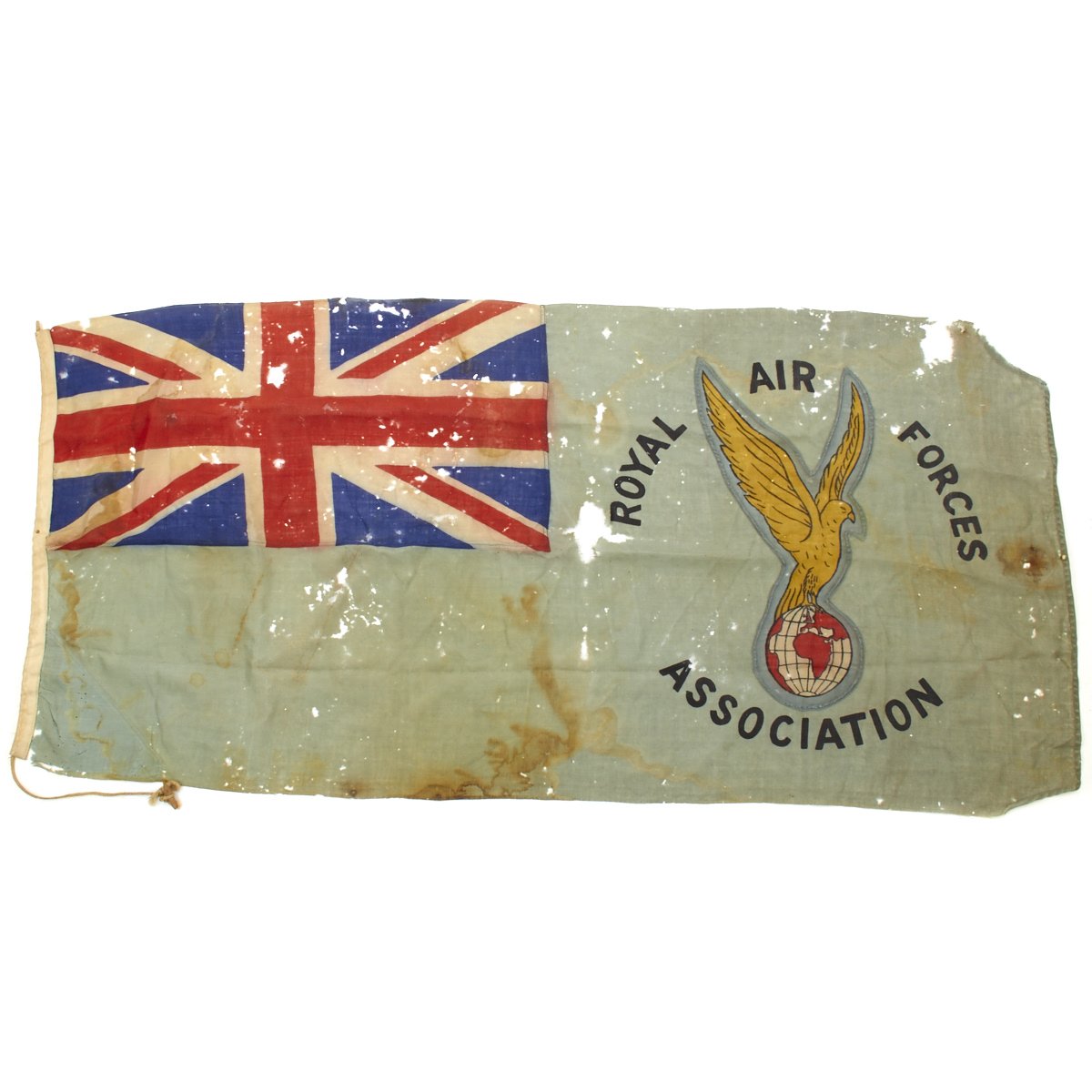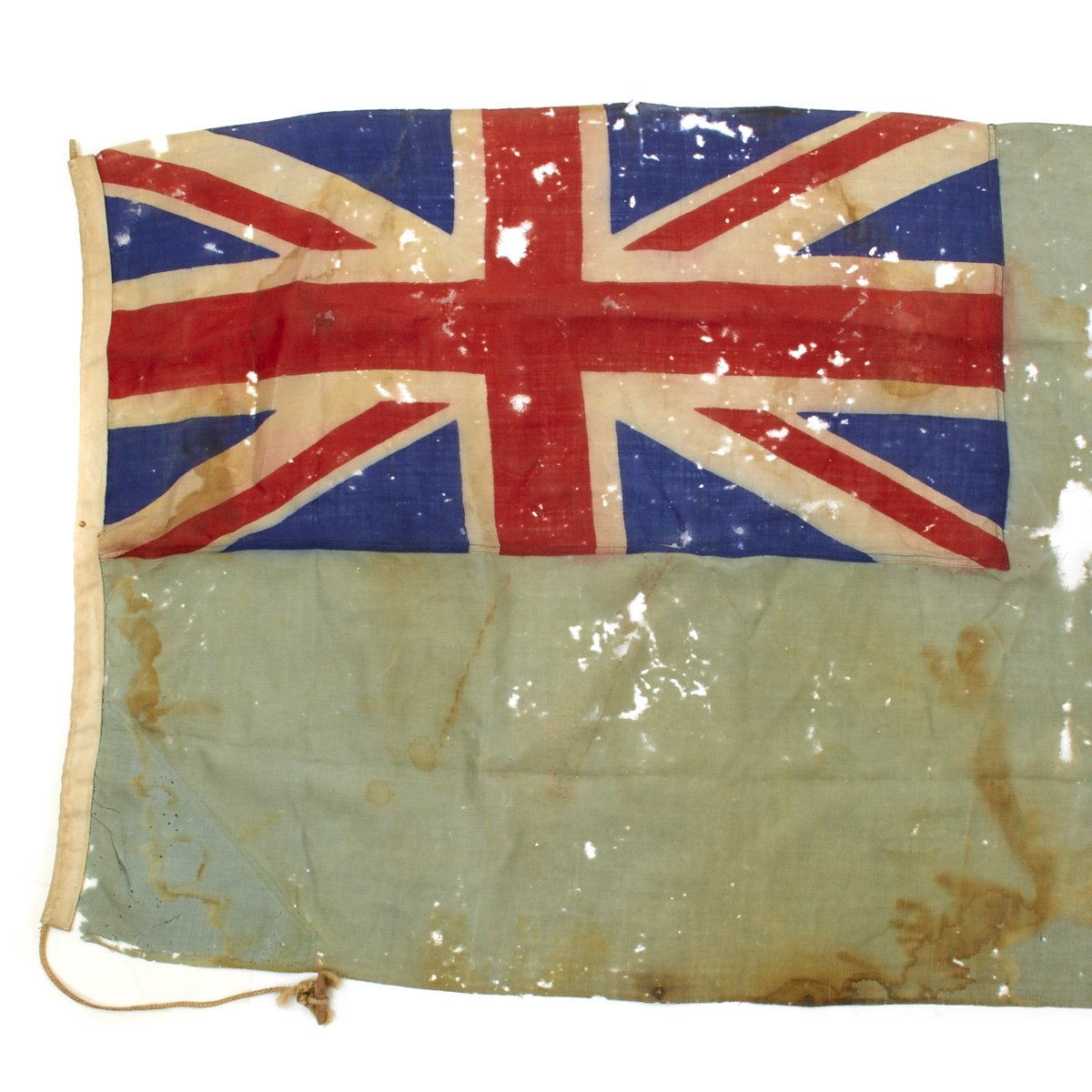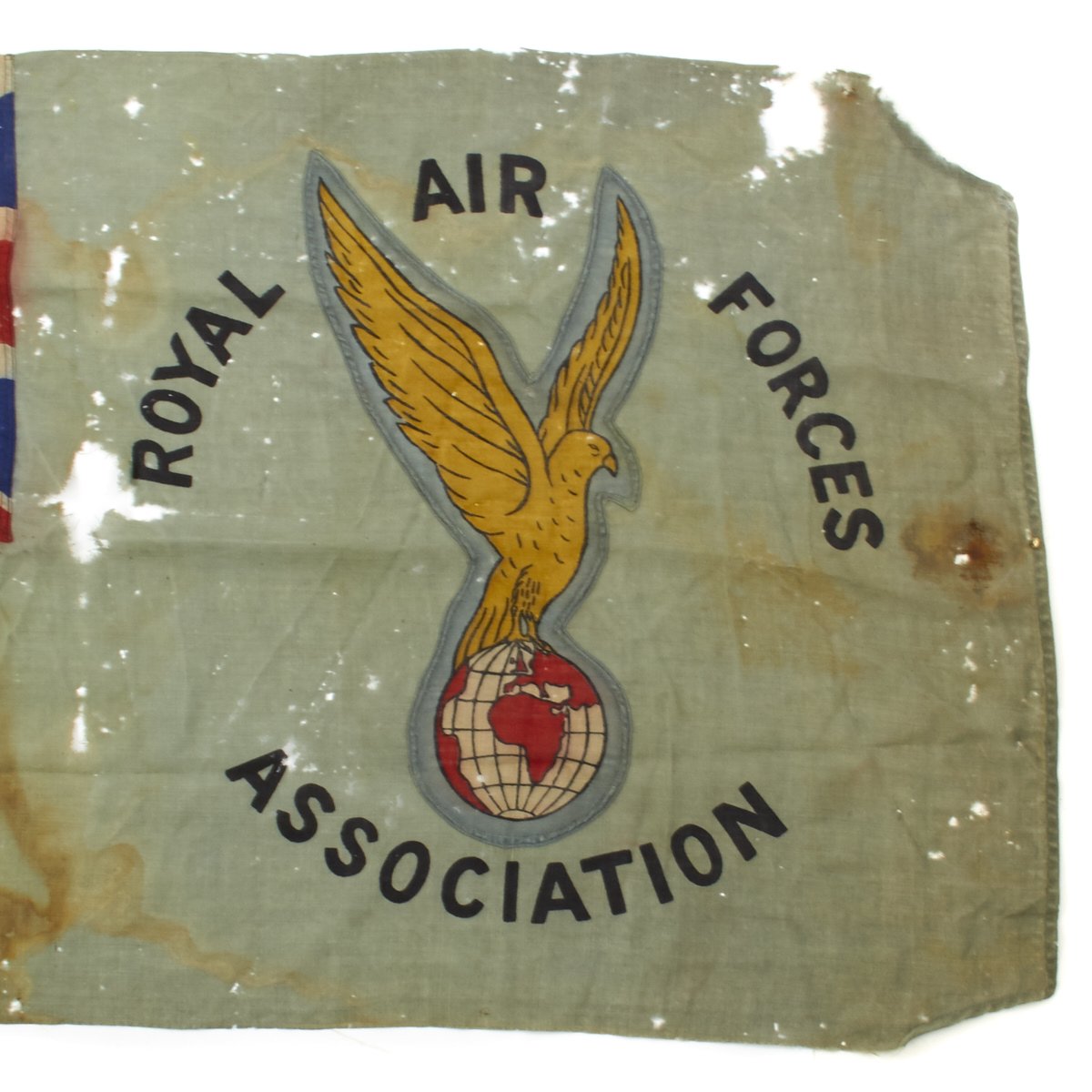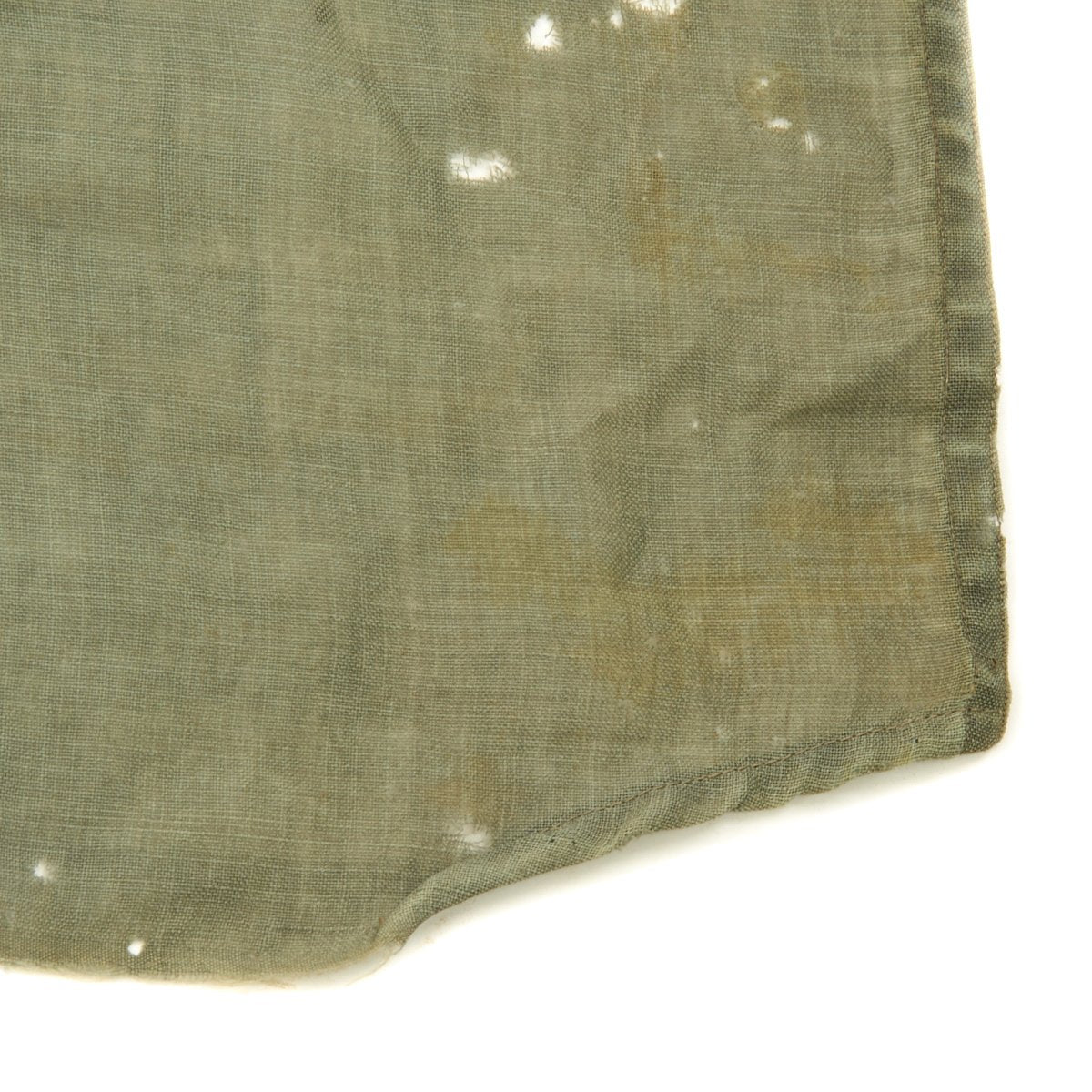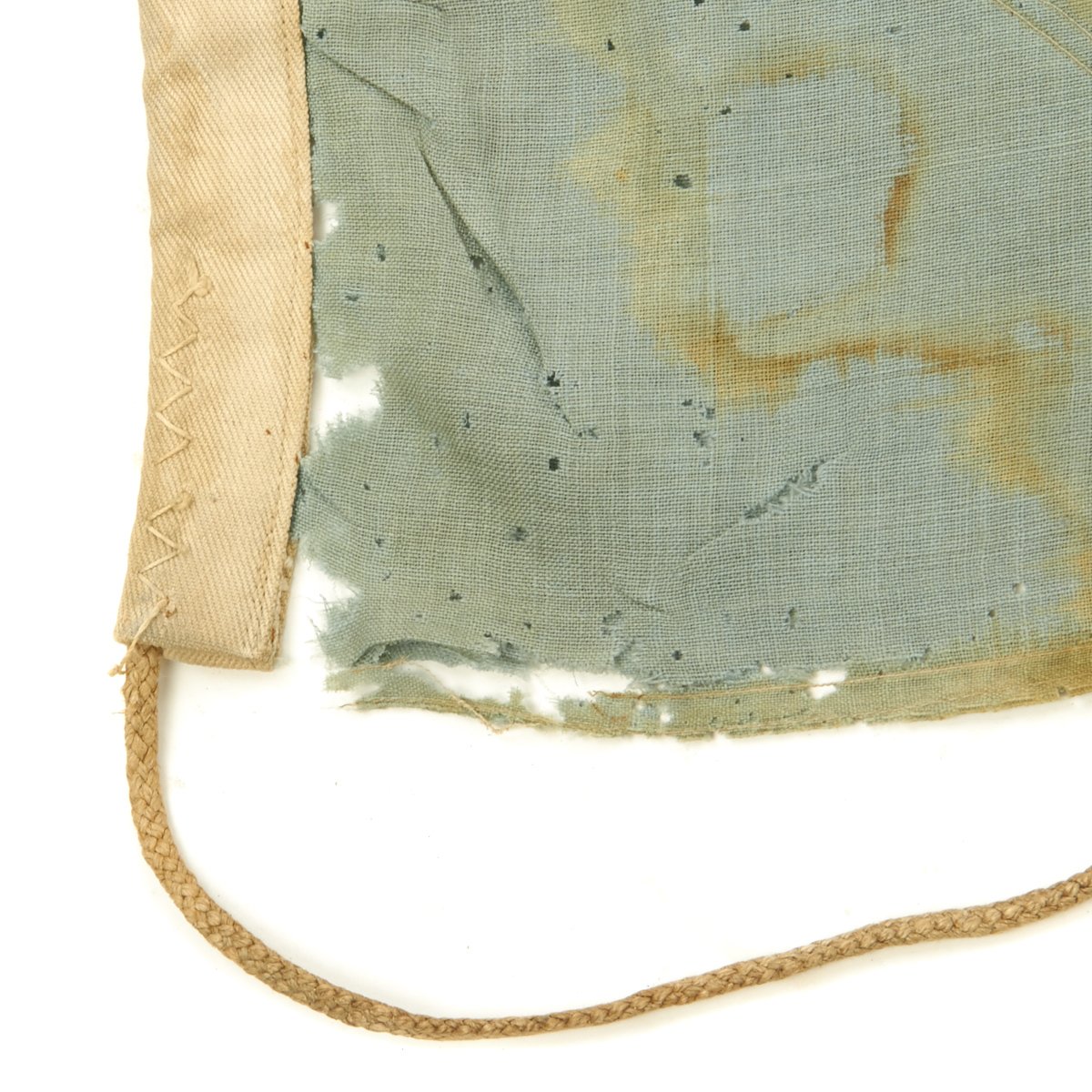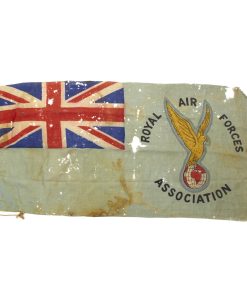Original British WWII Royal Air Forces Association Flag – 71 x 33 Original Items
$ 295,00 $ 118,00
Original Item: Only One Available. Dating from between 1936 and 1945 this is a wool flag that measures 71″ x 33″. It reads ROYAL AIR FORCES ASSOCIATION and features the insignia and Union Jack. Overall condition is good, with a few areas of loss, but overall quite solid. R.A.F.A. of this age are exceedingly rare and hard to find. Most RAFA flags on the market date from the 1960s and are made of synthetic material.
The Royal Air Forces Association (also called the RAF Association or RAFA) is the largest single Service membership organization and the longest standing registered service charity that provides welfare support to the RAF Family – providing friendship, help and support to current and former members of the Royal Air Force and their dependents.
History
1. At the end of the First World War a number of Squadron and Unit Associations were formed to enable those who had served together to maintain contact with one another..
2. In 1919, the women who had served with the Royal Air Force in the First World War formed an Old Comrades Association to which members of the Women’s Auxiliary Air Force were admitted.
3. In 1929, in the Sergeants’ Mess at RAF Andover, three men named Vernon Goodhand, Joe Pearce and Warrant Officer Bartlett met to discuss the formation of a single organisation dedicated to the welfare of serving and ex-serving RAF personnel: one which would replace the many smaller organisations that had grown to keep former servicemen in touch since the end of the First World War
4. It was a concept that reached the ears of William Coen, the editor of The Planesman – a publication that was widely read by airmen on the many RAF stations spread around the UK. A series of articles by William Coen supporting the idea produced much encouragement, and an inaugural meeting was held on 23 April 1930 at Ye Olde Butler’s Head in the City of London where preliminary plans for a national organisation were discussed, with Joe Pearce in the chair.
5. A provisional committee was formed with Air Commodore C R Samson as Chairman, Air Commodore B C H Drew as Vice-Chairman and editor William Coen as Honorary Secretary. The title ‘Comrades of the Royal Air Forces’ was adopted, and three months later in 1930 a provisional committee had been formed called “Comrades of the Royal Air Forces Association” and the first general meeting of the new organisation took place at the Queen’s Hotel, Leicester Square, London.
6. Air Ministry support for the Comrades came in 1933 when the Air Council officially recognised the organisation and Hugh Trenchard, 1st Viscount Trenchard accepted the Presidency.
7. The new Association was to make rapid progress in the early thirties, although membership was to remain fairly small. Benevolent schemes began, and Christmas hampers were sent to unemployed members in those difficult days. A very important event in the Association’s history came in 1936 when George V gave his patronage, and the Association has been honoured with Royal Patrons ever since. The size of the RAF remained modest until the effects of the re-armament programme began to be felt in 1938. The strength of the ‘Comrades’ was never to grow beyond 10,000 in pre-war days.
8. In 1936, His Majesty King George VI granted his Patronage to the Comrades of the Royal Air Forces and continued to be Patron when the name was changed to ‘The Royal Air Forces Association’.
9. Following the outbreak of war in 1939, the Women’s Auxiliary Air Force reformed, and the Women’s Royal Air Force Old Comrades Association (created in 1919) opened its membership to all ranks of the new female air service.
10. In 1941, the two Old Comrades organisations for airmen and airwomen merged, resulting in a combined membership of nearly 20,000.
11. By 1943, with more than a million serving in the RAF, it became clear that if the Association was to plan an effective part in the post-war era, it would need to be organised on a much sounder basis. The Association’s Committee in studying the organisation’s future role concluded that its aims and objectives should be extended beyond its original purpose “….to advise and assist all ranks leaving the Royal Air Force in regard to pensions, disability awards, grants, etc….. to assist all ranks leaving the Royal Air Force to find suitable employment; to advise and assist all ranks leaving the Royal Air Force upon any business or financial transaction connected with their re-entry into civil life; …. To co-operate with any Government department and/or other Organisations having similar objects to this Association.” The Air Council was advised that the Association was considering a change of name , that it desired to obtain a Royal Charter and that its support of the application would be sought in due course.
12. Interestingly, the Air Council in their reply said “It is understood that your Association has under consideration the question of adopting a more euphonious title. Such a change appears to the Council to be desirable, and they would suggest Royal Air Force Comrades Association as a possible new title.”
13. In 1943, the name of the organisation was changed to “The Royal Air Forces Association” with membership open to all who were serving or had served in the Royal Air Forces of the Crown. The Association was officially recognised by the Air Ministry. Branches were grouped into Regions. A National Council, under the chairmanship of Air Chief Marshal Sir John Steel was formed to replace the Committee of CRAFA, upon which Regions were represented, was formed and welfare services including legal and general advice, pensions and employment were instituted.
14. The foundations of the charity’s present structure were laid in the remaining wartime years, so that when demobilisation began in 1945 the Association was able to cope with the situation. Welfare officers , employment officials and legal advisers were appointed both at National Headquarters and at branch level and, at the Air Ministry ‘s invitation , officials went” to Release Centres to tell those being “demobbed ” how the Association could help them.
15. In 1947 membership reached a peak with around 200,000 members and some 565 branches throughout the UK and in some overseas territories. During this time, membership enrolment reached as many as 10,000 a month.
16. It is appropriate at this point to acknowledge the contribution made to the Association by Gerald Boak. Appointed in 1947 to the position of Chief Executive (the appointment was later renamed General Secretary and later still Secretary General), Gerald Boak did much to organise and lead the Association during a period when there was much uncertainty . That the Association was able to progress through the difficulties of those post-war years, that it was able to develop its Area structure and that its fund-raising potential began to be realised was due particularly to this man who served the Association so well for nearly 30 years.
17. In 1948, a policy of decentralisation was agreed whereby the United Kingdom was divided into nine Areas. Six Areas were formed in England and one each in Wales, Scotland and Northern Ireland. Each Area had an Area Headquarters with a paid Director and staff, an Area Council elected by the Branches in the Area and representation on the Council of the Association.
18. Overseas Branches were later formed into three groups for administration purposes. The South African Area has its own Area Council and looks after all Branches in that country. The European Area, comprising all the European Branches, also has an Area Council and is represented on the Council of the Association. Other Overseas Branches are classified as “Independent Overseas Branches”.
19. Welfare officers, employment officials and legal advisers were appointed at National Headquarters and at local branch levels. At the Air Ministry’s invitation officials attended Release Centres to inform demobilised Air Personnel how the Association could help them.
20. Following a 1950 Conference decision, a National Wings Day was held the next year and this, the first Wings Appeal, raised over £26,000.
21. Also in 1950, Her Royal Highness Princess Alice, Duchess of Gloucester consented to be Vice-Patron.
22. In 1952, on her accession to the Throne, Elizabeth II continued the Royal tradition by becoming Patron and, on the 20th January 1953, granted a Royal charter to the Association.
23. February 1958 saw the opening at Lytham St Anne’s , Lancashire, of the Association ‘s first convalescent and rest home , named Richard Peck House in honour of Air Marshal Sir Richard Peck – who after Lord Trenchard and Lord Newall, had become, in 1949, President of the RAFA .
24. In 1962 the Association acquired “Sussexdown” in Storrington, Sussex as part of a plan to provide a dual-purpose home in the south of England. Within a couple of years “Sussexdown” was to have a Residential Wing as well as providing convalescent facilities.
25. We were also honoured and proud to have the Duke of Edinburgh as President in 1954 – 55, 67 – 69 and again in 1993, and the Prince of Wales in 1986. The Duke of Cambridge became a member of the Association in 2014.
26. The difficulties of obtaining suitable housing for elderly, and often disabled members, had long concerned the Association. The Norwest Housing Association completed a project involving the construction of 22 self-contained flats at Bolton in 1976, initiating thereby an important addition to the Association’s range of welfare facilities. Later the Central Housing Association was given approval for the construction of 32 double flats on vacant space at Sussexdown; construction work on this project began in 1978.
27. The next major project to be undertaken was that at Dowding House, Moffat. This scheme was completed in October 1988, and included the creation of a complex of self-contained flats, a communal lounge, conservatory, laundry facilities and a guest room·. A care-call system was installed in all the flats and a resident warden appointed.
28. At the start of the 21st Century it was clear that the Association needed to adapt to an ever-changing society and its welfare needs. The RAF Association underwent a complete reorganisation and the National Headquarters relocated to the heart of the country in Leicester, and in the process amalgamated the Association’s Areas into five.
29. In recent times the Association has continued to be at the forefront of providing support to the RAF family. As well as continuing to help those who served in World War II, we have given assistance to vast numbers of Service personnel including veterans of the conflicts in Korea, The Falklands and The Middle East, and those affected by the campaign in Afghanistan and elsewhere.
30. In 2003 Areas in the UK were merged into: Northern; South East & Eastern; and Wales, Midland & South Western followed by Scotland & Northern Ireland in 2004.
31. Today, the RAF Association carries on its vital work and is needed even more than ever. The Association continues to operate a wide network of over 422 branches worldwide, and has a membership of over 61,900. Our Welfare Officers continue to seek out those in welfare need and provide a range of services to help ease their suffering. Over eighty years later and we’re still making a huge difference to the lives of former servicemen and their families.
Fast Shipping with Professional Packaging
Thanks to our longstanding association with UPS FedEx DHL, and other major international carriers, we are able to provide a range of shipping options. Our warehouse staff is expertly trained and will wrap your products according to our exact and precise specifications. Prior to shipping, your goods will be thoroughly examined and securely secured. We ship to thousands clients each day across multiple countries. This shows how we're dedicated to be the largest retailer on the internet. Warehouses and distribution centres can be located throughout Europe as well as the USA.
Note: Orders with more than one item will be assigned a processing date depending on the item.
Before shipping before shipping, we'll conduct a thorough inspection of the items you have ordered. Today, the majority of orders will be delivered within 48 hours. The delivery time will be between 3-7 days.
Returns
The stock is dynamic and we cannot completely manage it because multiple stakeholders are involved, including our factory and warehouse. So the actual stock may alter at any time. It's possible that you may not receive your order once the order has been made.
Our policy is valid for a period of 30 days. If you don't receive the product within 30 days, we are not able to issue a refund or an exchange.
You can only return an item if it is unused and in the same state as the day you received it. You must have the item in its original packaging.
Related products
Uncategorized
Uncategorized
Armored Burgonet Helmet & Polearm from Scottish Castle Leith Hall Circa 1700 Original Items
Uncategorized
Uncategorized
Angolan Rebel 1970s era 60mm Inert Display Mortar from Angolan Civil War Original Items
Uncategorized
Uncategorized
Armoured Fighting Vehicles of the World: AFVs of World War One (Hardcover Book) New Made Items
Uncategorized
Uncategorized
Uncategorized
Uncategorized
Australian WWII Owen MK1 Machine Carbine SMG Custom Fabricated Replica with Sling Original Items
Uncategorized
Uncategorized
Uncategorized
Uncategorized
Uncategorized
Uncategorized
Uncategorized
Uncategorized
